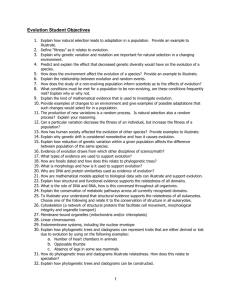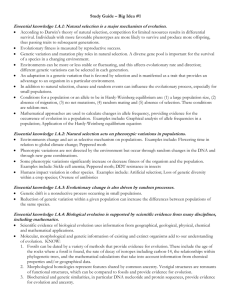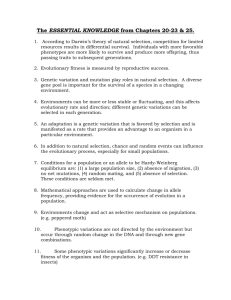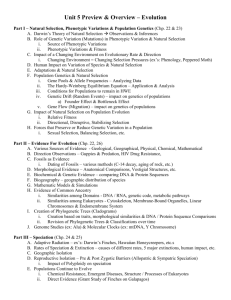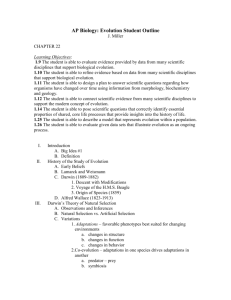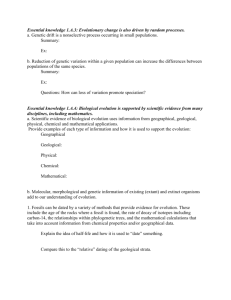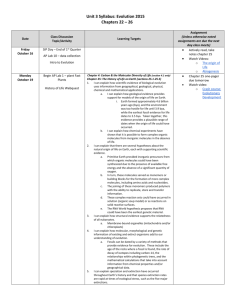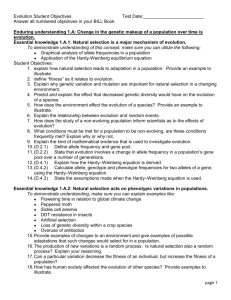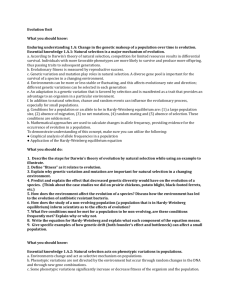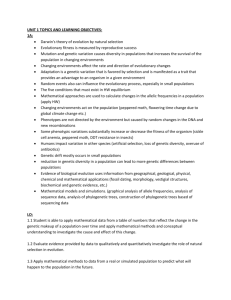Big Idea #1 Evolution
advertisement
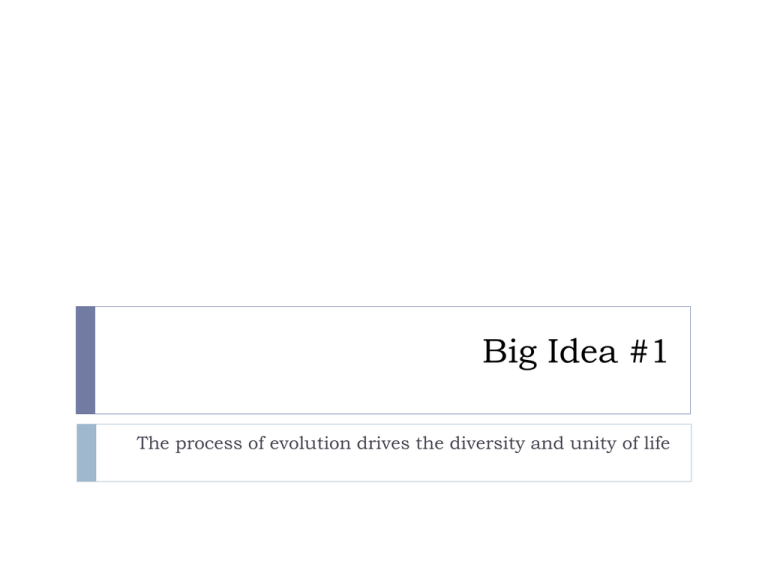
Big Idea #1 The process of evolution drives the diversity and unity of life Natural selection is a major mechanism of evolution According to Darwin’s theory of natural selection, competition for limited resources results in differentia survival. Individuals with more favorable phenotypes are more likely to survive and produce more offspring, thus passing traits to subsequent generations. Evolutionary fitness is measured by reproductive success. Genetic variation and mutation play roles in natural selection. A diverse gene pool is important for the survival of a species in a changing environment. Environments can be more or less stable or fluctuating, and this affects evolutionary rate and direction; different genetic variations can be selected in each generation. An adaptation is a genetic variation that is favored by selection and is manifested as a trait that provides an advantage to an organism in a particular environment. In addition to natural selection, chance and random events can influence the evolutionary process, especially for small populations. There are 5 conditions needed for a population to be in Hardy-Weinberg equilibrium: large size; no migration; no net mutations; random mating, no selection. Mathematical approaches are used to calculate changes in allele frequencies, providing evidence for the occurrence of evolution in a population. Natural selection acts on phenotypic variations in populations Environments change and act as selective mechanisms on populations Phenotypic variations are not directed by the environment but occur through random changes in the DNA and through new gene combinations Some phenotypic variations significantly increase or decrease fitness of the organism and the population Flowering time in relation to global climate change Peppered moth Sickle cell anemia Peppered moth DDT resistance in insects Humans impact variation in some species Artificial selection of domesticated animals and crops Loss of genetic diversity within a crop species Overuse of antibiotics Evolutionary change is also driven by random processes Genetic drift is a nonselective process occurring in small populations. Reduction of genetic variation within a given population can increase the differences between populations of the same species. Biological evolution is supported by scientific evidence from many disciplines, including mathematics Scientific evidence of biological evolution uses information from geographical, geological, physical, chemical, and mathematical applications Molecular, morphological and genetic information of existing and extinct organisms add to our understanding of evolution. Fossils can be dated by a variety of methods that provide evidence for evolution: age of the rocks where a fossil is found, the rate of decay of isotopes such as C-14, relationships with phylogenetic trees, mathematical calculations that consider chemical properties and/or geographical data Morphological homologies represent features shared by common ancestry.Vestigial structures are remnants of functional structures which can be compared to fossils Biochemical and genetic similarities, in particular DNA nucleotide and protein sequences, provide evidence for evolution and ancestry Mathematical models and simulations can be used to illustrate and support evolutionary concepts Organisms share many conserved core processes and features Structural and functional evidence supports the relatedness of all domains DNA and RNA are carriers of genetic information through transcription, translation, and replication Major features of the genetic code are shared by all modern living systems Metabolic pathways are conserved across all currently recognized domains Structural evidence supports the relatedness of all eukaryotes Cytoskeleton Membrane-bound organelles Linear chromosomes Endomembrane systems, including the nuclear envelope Phylogenetic trees and cladograms are models of evolution that can be tested Phylogenetic trees and cladograms can represent traits that are either derived or lost due to evolution Number of heart chambers in animals Opposable thumbs Absence of legs in some sea mammals Phylogenetic trees and cladograms illustrate speciation that has occurred; relatedness of any two groups on the tree is shown by how recently two groups had a common ancestor Phylogenetic trees and cladograms can be constructed from morphological similarities of living or fossil species, and from DNA and protein sequence similarities, using computer programs to measure and represent relatedness Phylogenetic trees and cladograms are dynamic (constantly being revised), based on the biological data used, new mathematical and computational ideas, and current and emerging knowledge Speciation and extinction have occurred throughout the Earth’s history Speciation rates can vary, especially when adaptive radiation occurs when new habitats become available Species extinction rates are rapid at times of ecological stress Five major extinctions Human impact of ecosystems and species extinction rates Speciation may occur when two populations become reproductively isolated Speciation results in diversity of life forms. Species can be physically separated by a geographic barrier such as an ocean or a mountain range, or various pre- and postzygotic mechanisms can maintain reproductive isolation and prevent gene flow New species arise from reproductive isolation over time, which can involve scales of hundreds of thousands or even million of years, or speciation can occur rapidly through mechanisms such as polyploidy in plants Populations of organisms continue to evolve Scientific evidence supports the idea that evolution has occurred in all species Scientific evidence supports the idea that evolution continues to occur Chemical resistance (antibiotic, pesticide, chemotherapy drugs) Emergent diseases Observed directional phenotypic change in a population (Darwin’s finches in the Galapagos) There are several hypotheses about the natural origin of life on Earth, each with supporting scientific evidence Primitive Earth provided inorganic precursors from which organic molecules could have been synthesized due to the presence of available free energy and the absence of a significant quantity of oxygen. In turn, these molecules served as monomers or building blocks for the formation of more complex molecules, including amino acids and nucleotides The joining of these monomers produced polymers with the ability to replicate, store, and transfer information These complex reaction sets could have occurred in solution (organic soup) or as reactions on solid reactive surfaces The RNA World hypothesis proposes that RNA could have been the earliest genetic material Scientific evidence from many different disciplines supports models of the origin of life Geological evidence provides support for models of the origin of life on Earth The Earth formed approximately 4.6 billion years ago. The environment was too hostile for life until 3.9 billion years ago. The earliest fossil evidence for life dates to 3.5 billion years ago. Taken together, this evidence provides a plausible range of date when the origin of life could have occurred Chemical experiments have shown that it is possible to form complex organic molecules from inorganic molecules in the absence of life Molecular and genetic evidence from extant and extinct organisms indicates that all organisms on Earth share a common ancestral origin of life Scientific evidence includes molecular building blocks that are common to all forms of life Scientific evidence includes a common genetic code

